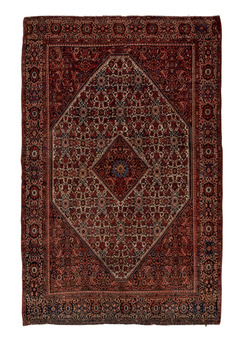Antique rug No. 68001 Sarouk Farahan, ca. 1910 Iran 190 x 127 cm

Larger images (will open in new window)
Please click on the thumbnails below for a larger view
| main view |
Image 2 |
Image 3 |
Image 4 |
Image 5 |
 |
 |
 |
 |
 |
| Image 6 |
 |
| Item Number: |
68001 |
| Name: |
Sarouk Farahan, ca. 1910 |
| Country of Origin: |
Iran |
| Size: |
190 x 127 cm |
| Made:
|
ca. 1910 |
| Pile: |
wool |
| Design: |
geometric / medallion |
| Ground Color: |
beige / dark blue / navy |
| Remarks: |
This is a unique handmade / hand-knotted / traditional oriental carpet
The pile of this carpet is made of wool |
 add to cart
add to cart
More about the provenance Sarouk Farahan, ca. 1910 | Iran
Sarouk is located in West Iran, in the zone of production of Arak. The source of this important provenance has been in the village of Sarouk (also written Sarough) North of Arak. Sarouks are known to be of high quality. The pile is usually higher than the average Persian rug and therefore Sarouks are rather heavy and solid rugs, the wool being used is high quality durable wool. Sarouk Farahan (Feraghan) rugs are influenced by the Feraghan tradition in design and colors. Farahan is an important carpet center and is located in the triangle Qum-Arak-Hamadan in Central Persia in a highland. Farahan's peak time was in the 18th century when Nadir Shah settled carpet makers here (therefore probably the high number of Herati- (Mahi-) designs in Farahan rugs. Most of the old Farahan carpets were made in Muskabad, which was destroyed completely at the end of the 19th century. That was also the time when Farahan rugs were extremely popular in England, being called the "Gentleman carpet". Their fundament is mostly quite thick and the pile is always made of first class wool. Old and antique Farahans are rare and very valuable rugs with subtle colors and designs.
This Sarouk Farahan, ca. 1910 has a "Herati" or "Mahi" design (has its origin in Herat, ca. 16th century, short for "Mahi to Hos" meaning "fish in the pond"). A rosette is surrounded by a rhombus which is again surrounded by four bent leaves. The name "Mahi" meaning "fish" was given to this design because the leaves resemble swimming fish.

